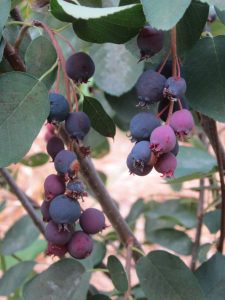Saskatoons – true Western Canada fruit
Saskatoons are a true Western Canada fruit; they sustained First Nations over millennia and by extension newcomers.
Saskatoons (Amelanchier alnifolia) are bushy shrubs native to Western Canada, growing on riverbanks, the slopes of coulees and as high as 3400 m. in the Rocky Mountains. The white blossoms appear in the mid spring and turn into clusters of purplish fruits – do not add the word berries at the end of the name, by the way. First Nations peoples used saskatoons to flavor pemmican and early settlers made them into jam, jelly and pies.
The name “saskatoon” is supposed to come from the Cree language: misâskwatômina[i]. It’s also called Pacific serviceberry, western serviceberry, alder-leaf shadbush, dwarf shadbush, chuckley pear, western juneberry and pigeon berry. Saskatoons contain higher levels of protein, fat, and fiber than most other fruit, at least four anthocyanins but not particularly high in ascorbic acid (Vitamin C)[ii]. The French name for saskatoons is “petite poire sauvage” – “little wild pears”, indicating that they are pomes (like apples and pears), not true berries.
Thirty or forty years ago, saskatoons could only be picked in the wild, but these days it is becoming a commercial crop; the fruit mostly ripens evenly, making picking easier. It is not as fussy about acidity in soils compared to blueberries, which is a somewhat similar crop [iii]. The saying is that wherever wheat will grow, so will saskatoons[iv].
Try saskatoons in any recipe that calls for berries – pies, muffins, biscuits, cheesecake toppings, jams and jellies. They can also be canned, frozen or dried. 
[i] http://saskatoonberryinstitute.org/saskatoons/
[ii] http://www.hort.purdue.edu/newcrop/proceedings1993/V2-516.html#CULTIVARS
[iii] http://saskatoonberryinstitute.org/saskatoons/
[iv] http://plantwatch.naturealberta.ca/choose-your-plants/saskatoon/

